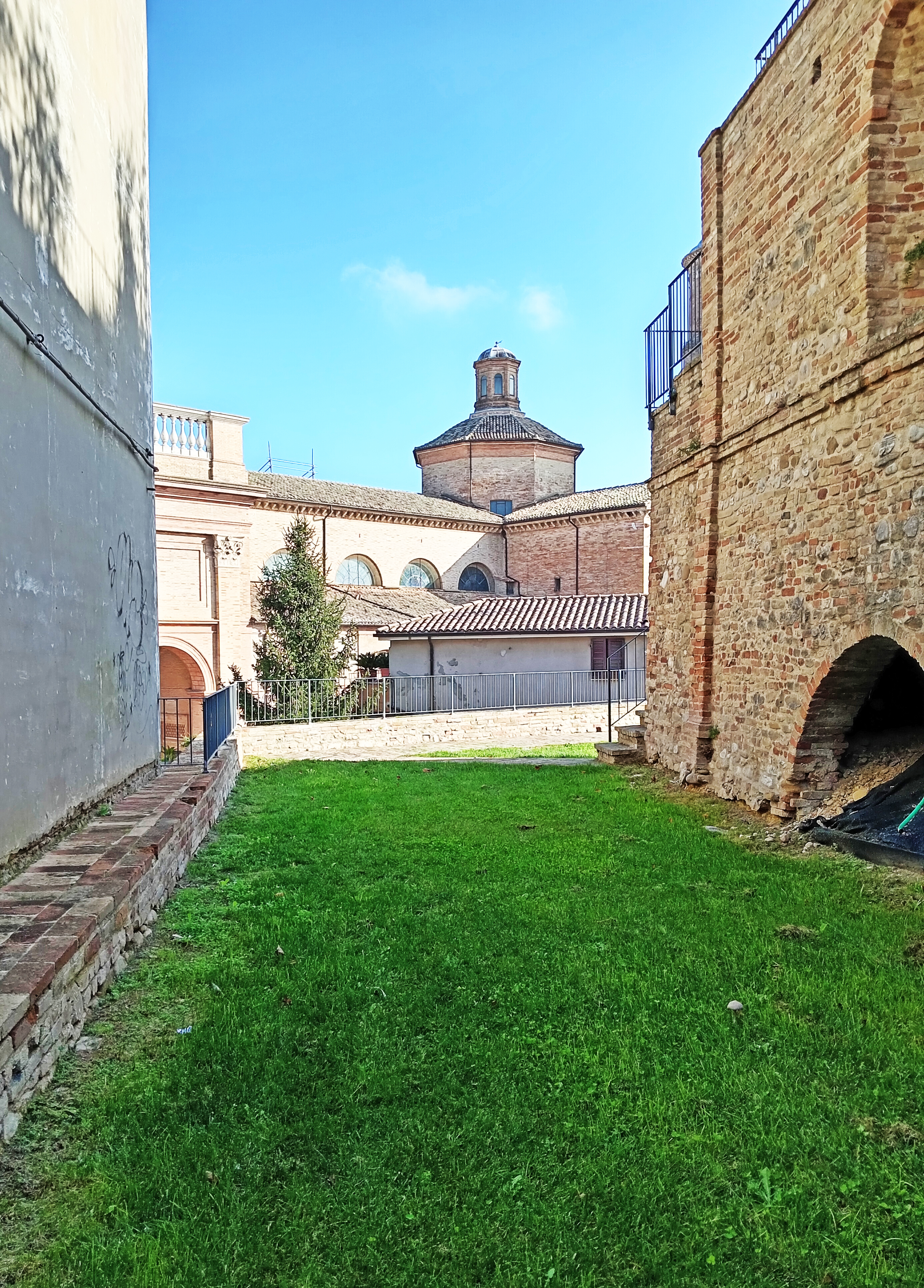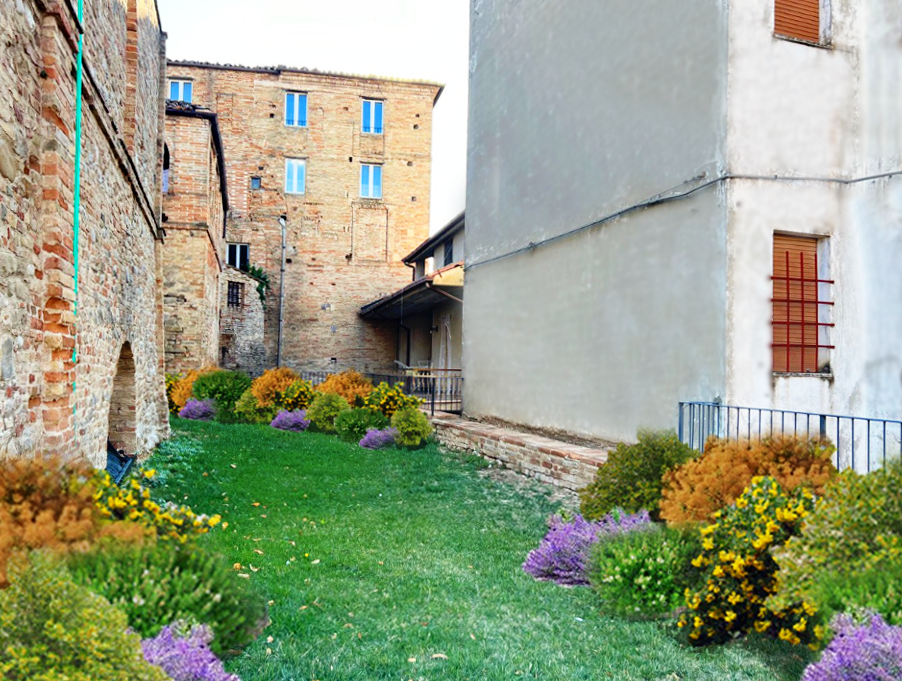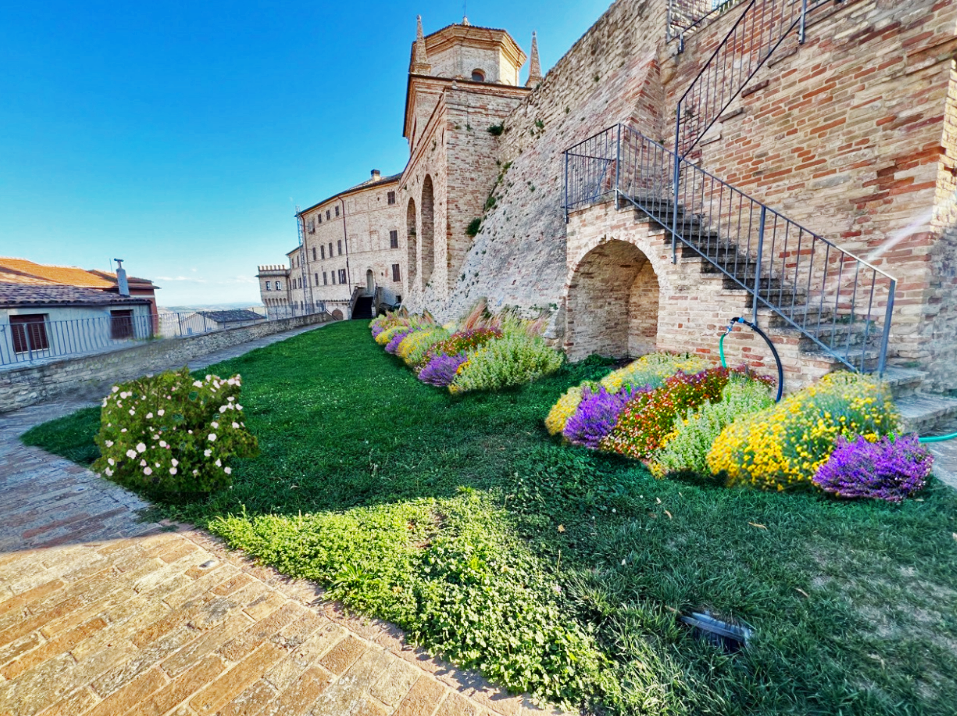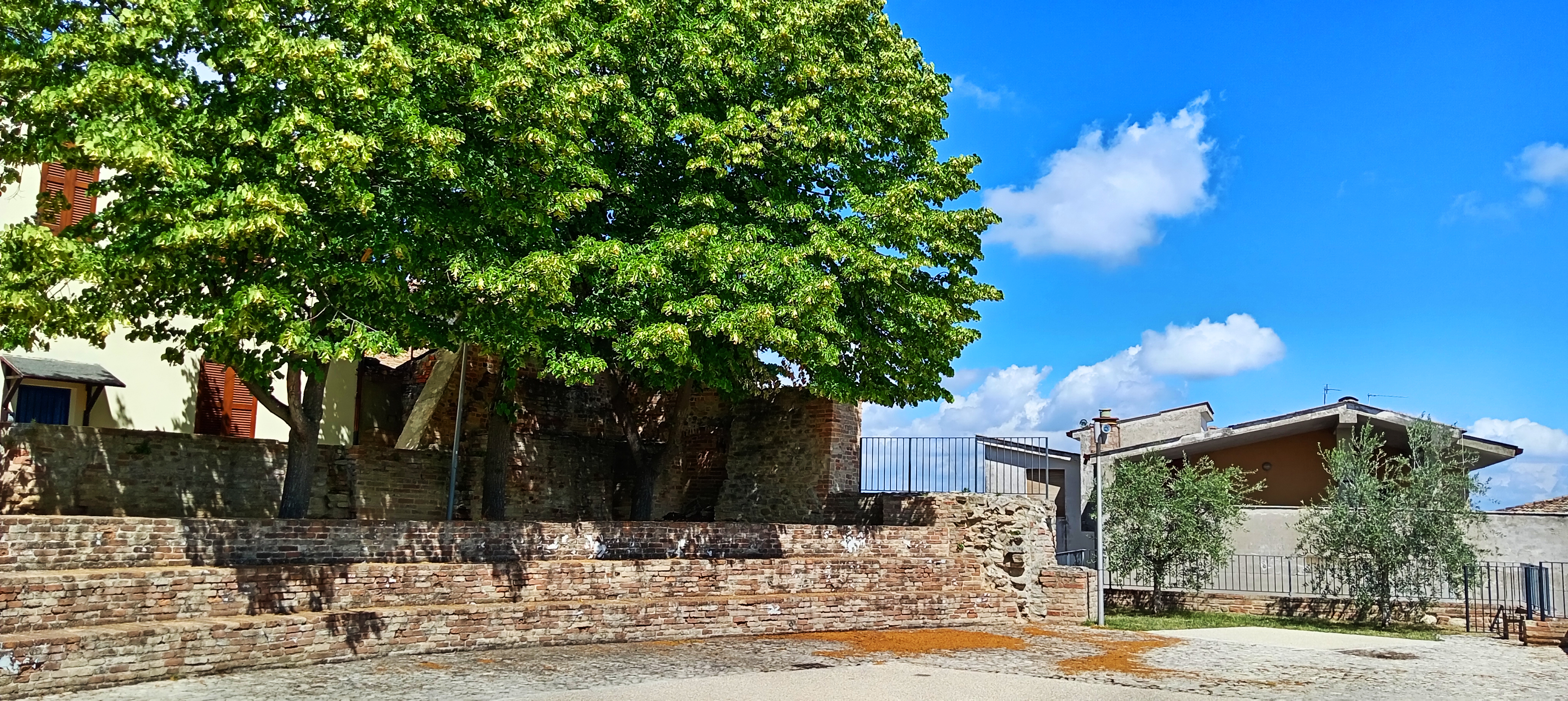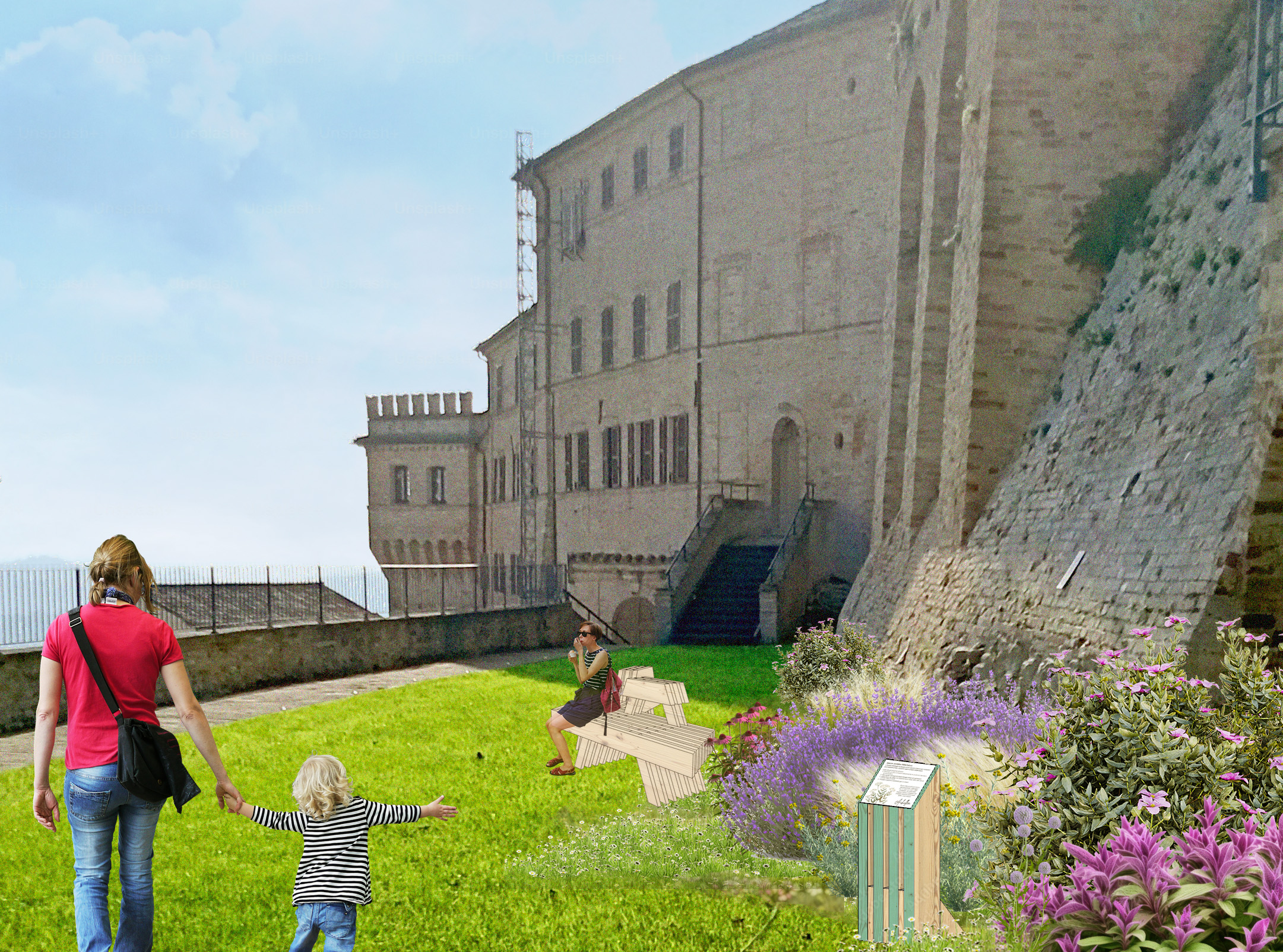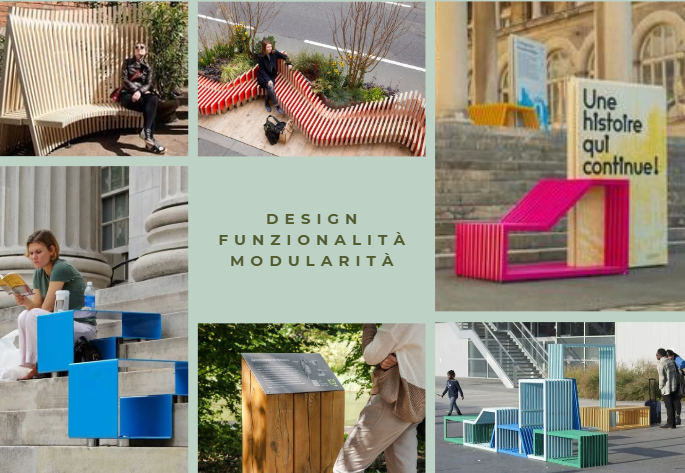VERDEBORGO
VERDEBORGO. Rethinking urban green spaces between ecology, design and participation
A project of urban green regeneration to create new landscape aesthetics and new community values through a participatory, sustainable and inclusive process. Thanks to co-design and self-construction workshops, botanical walks and participative planting, the community becomes the protagonist of a lasting change that integrates beauty, ecology and active citizenship, redeveloping urban living spaces and strengthening a sense of belonging and co-responsibility.
Italy
Palazzo Paradisi - Corso Vittorio Emanuele, 59, 63068 Montalto delle Marche AP
Early initiative
Yes
Yes
Yes
No
No
044032: Montalto delle Marche (IT)
The project is part of the larger initiative "METROBORGO-MontaltoLab", selected as a pilot project by the Region Marche for the PNRR call "Attractiveness of Villages"-Line A with the aim to guide an urban redevelopment process with a place based approach and with a systemic thinking at cultural, touristic and socio-economic level.The Municipality of Montalto delle Marche has launched a participatory process of regeneration of urban green in order to improve this strategy, financed through the regional call "Borgo Accogliente". The village in fact is characterized by the presence of urban green heritage – both public and private - that must be conceived as "asset of collective interest", "multifunctional resource" in service of the entire community and able to create benefits for the environment and the society. The overall goal of the project is therefore to co-create a new aesthetic and poetic of the urban green as an element capable of generating “wellbeing vibes” cin order to increase both quality of life and tourism attractiveness (target: residents and tourists, especially young generations).
Project Specific Goals (SG) and expected results:
SG1 - Redevelopment of the urban landscape combining environmental sustainability, aesthetic quality and well-being
Result: eco-management guidelines for the implementation of best practices of green regeneration in line with the quality and the biodiversity of the Valdaso landscape (Valdaso is the valley which surrounds the village)
SG2 - Development of an eco-pilot as the first hub for a network of urban-green experiences
Result: creation of a “green room” in the Palazzo Paradisi’s garden, future socio-cultural hub that will host the headquarters of the village’s associations and cooperatives
SG3 - Co-responsibility of the local community through a participatory development of the green regeneration’s path and future co-management of urban green areas
Results: community green diary and community urban green charter
Project Specific Goals (SG) and expected results:
SG1 - Redevelopment of the urban landscape combining environmental sustainability, aesthetic quality and well-being
Result: eco-management guidelines for the implementation of best practices of green regeneration in line with the quality and the biodiversity of the Valdaso landscape (Valdaso is the valley which surrounds the village)
SG2 - Development of an eco-pilot as the first hub for a network of urban-green experiences
Result: creation of a “green room” in the Palazzo Paradisi’s garden, future socio-cultural hub that will host the headquarters of the village’s associations and cooperatives
SG3 - Co-responsibility of the local community through a participatory development of the green regeneration’s path and future co-management of urban green areas
Results: community green diary and community urban green charter
Urban green regeneration
Poetics of urban landscape
Quality of life
Community eco-pilot
Co-design, co-implementation and co-management
The project involves the development of strategic and operational guidelines for the creation of a resilient and sustainable urban green system, in line with the carbon neutrality goal contained in the European Green Deal and focusing on the adoption of natural-based solutions to enhance local biodiversity and deal with major environmental issues. In particular, the solutions adopted will play a key role in reducing the use of water needed for irrigation through the choice of xerotherm species; moreover all the plants - selected on the advice of botanical experts and university professors - are autochthonous or allochthonous species which are non invasive and resistant to disease and attacks by phytopharmaceuticals, but at the same time they can ensure flowering at different times of the year, also providing a constant food resource for insects and ensuring respect for local biodiversity.
Urban green planning also aims to foster patterns of urban green design that can reproduce elements of the surrounding landscape or restore pieces of natural ecosystems typical of the territory. The establishment of tree-lined urban green areas and de-impermeable areas will also be promoted to reduce the effects of heat bubbles and create thermoregulated islands.
According to the principles of the circular economy, the project aims to promote the use of loam and fertilizers obtained exclusively from the recycling of solid organic waste generated from the maintenance of local green areas and agricultural production, and from the reuse of waste material for the eco-pilot project.
The focus is rethinking services and places with the integration of public and private management areas, which claim to create a common sensitivity and consciousness, and a sharing of knowledge and best practices.
Urban green planning also aims to foster patterns of urban green design that can reproduce elements of the surrounding landscape or restore pieces of natural ecosystems typical of the territory. The establishment of tree-lined urban green areas and de-impermeable areas will also be promoted to reduce the effects of heat bubbles and create thermoregulated islands.
According to the principles of the circular economy, the project aims to promote the use of loam and fertilizers obtained exclusively from the recycling of solid organic waste generated from the maintenance of local green areas and agricultural production, and from the reuse of waste material for the eco-pilot project.
The focus is rethinking services and places with the integration of public and private management areas, which claim to create a common sensitivity and consciousness, and a sharing of knowledge and best practices.
Montalto delle Marche, like many others little Italian municipalities, is characterized by green areas consisting of old plants randomly arranged, without an ecological or aesthetic connection, resulting in the presence of non-authoctone green islands which are non-educative for citizenship (in fact, also the private green areas get used to these non-models) and which dequalify the values of urban landscape. On this matter, the project aims to introduce new visions and good practices about the aesthetic and functional redeveloping of urban green infrastructures, pursuing renewed values of harmony and balance between the built and green components and creating new aesthetic values of the urban landscape thanks to its diversification through colors, forms and density of the vegetation.
Specifically, the eco-pilot realization involves the community and stakeholders committed in the co-construction of urban-green furniture at the gardens of Palazzo Paradisi, which, thanks to the project "METROBORGO - MontaltoLab", will become the beating heart of local associationist life. The self-construction action represent the core of a participatory process in progress, which includes a set of awareness events, co-design workshops and co-implementation activities aimed at:
- grafting good practices of re-design of the urban-green landscape’s aesthetics in a creative way, functional to increase the aesthetic quality and attractiveness of the village
- fostering a sense of connection and belonging to the regenerated sites through the use of participatory co-design and co-implementation modalities
- spreading new attention on the theme of urban greenery as an element capable of generating benefits for the community also in terms of social welfare and tourist attractiveness
- introducing lasting cultural and social values through co-creation activities.
Specifically, the eco-pilot realization involves the community and stakeholders committed in the co-construction of urban-green furniture at the gardens of Palazzo Paradisi, which, thanks to the project "METROBORGO - MontaltoLab", will become the beating heart of local associationist life. The self-construction action represent the core of a participatory process in progress, which includes a set of awareness events, co-design workshops and co-implementation activities aimed at:
- grafting good practices of re-design of the urban-green landscape’s aesthetics in a creative way, functional to increase the aesthetic quality and attractiveness of the village
- fostering a sense of connection and belonging to the regenerated sites through the use of participatory co-design and co-implementation modalities
- spreading new attention on the theme of urban greenery as an element capable of generating benefits for the community also in terms of social welfare and tourist attractiveness
- introducing lasting cultural and social values through co-creation activities.
The whole project aims to promote and implement activities of active citizenship and empowerment of the local community and stakeholders involved both in terms of awareness of the value of green heritage of their urban context, both in terms of guidance and orientation towards more sustainable behavioural models. In line with this philosophy, all actions have been designed according to criteria of participatory inclusiveness and are aimed at activating virtuous mechanisms of mutual engagement oriented to the implementation of eco-friendly behaviours. Provided free of charge with hybrid modalities of participation, the actions are designed to allow everyone to take part in a moment of sharing and to take a valuable recreational opportunity. In particular, the design and implementation of the eco-pilot take into account the principles and guidelines of Design for All in order to make a more effective use of an experience that wants to be both an occasion of reconnection with a natural world - now indispensable to reintegrate with the urban one - and an opportunity to build new models of shared care for those green spaces that the community itself has helped to realize, through autonomous modes of self-government.
The project’s main focus is the ongoing stakeholder engagement process, whose purpose is not only to initiate a participatory design process with local actors and expertise involved, but also to activate a mechanism of co-responsibility of the community that can become a system of self-governance of urban green areas.
The citizens’ direct input is essential for the implementation of the eco-pilot at the gardens of Palazzo Paradisi, but informations, visions and common objectives shared during the collaborative process planned (see next paragraph) will also generate paths of collective empowerment with a view to acquiring knowledge and tools for the care and management of urban greenery, both public and private. The actions thus implemented aim to generate the following impacts:
- increase of social cohesion through active community involvement and strengthening of the bond between people and their territory
- enhancing of the natural and urban heritage through the creation of more accessible and functional spaces
- promotion of a replicable model for urban regeneration, based on sustainability and inclusion
- dissemination of local expertise in self-construction and shared management of public spaces
Furthermore, this regeneration process based on participation and the use of sustainable principles will generate a lasting impact on the quality of life in the village in terms of not only environmental benefits but also:
- aesthetic-cultural terms, to create new aesthetic values of the urban landscape and consequent enhancement of the city context;
- social and health terms, thanks to the positive influence of nature contact experiences on physical and mental health;
- economic terms, in a perspective of overall valorization of the urban area with increase in the economic value also of the individual properties and increase in tourist attractiveness.
The citizens’ direct input is essential for the implementation of the eco-pilot at the gardens of Palazzo Paradisi, but informations, visions and common objectives shared during the collaborative process planned (see next paragraph) will also generate paths of collective empowerment with a view to acquiring knowledge and tools for the care and management of urban greenery, both public and private. The actions thus implemented aim to generate the following impacts:
- increase of social cohesion through active community involvement and strengthening of the bond between people and their territory
- enhancing of the natural and urban heritage through the creation of more accessible and functional spaces
- promotion of a replicable model for urban regeneration, based on sustainability and inclusion
- dissemination of local expertise in self-construction and shared management of public spaces
Furthermore, this regeneration process based on participation and the use of sustainable principles will generate a lasting impact on the quality of life in the village in terms of not only environmental benefits but also:
- aesthetic-cultural terms, to create new aesthetic values of the urban landscape and consequent enhancement of the city context;
- social and health terms, thanks to the positive influence of nature contact experiences on physical and mental health;
- economic terms, in a perspective of overall valorization of the urban area with increase in the economic value also of the individual properties and increase in tourist attractiveness.
The project’s engagement process was conceived as:
- multi-stakeholder, addressing heterogeneous components of the citizenry, with particular reference to the younger generation, and providing for the direct involvement of expertise from the green sector at local, regional and national levels;
- multi-level, ensuring hybrid, flexible and suitable participatory modes for various types of target.
On an institutional level, a framework agreement has been signed between the Municipality of Montalto delle Marche and the University of Camerino for the implementation of actions for the redevelopment of urban and peri-urban green: a professor from the Biosciences Department, who is also an expert in Botanical, is collaborating on the design and conduct of project’s events and workshops with the community.
These activities also involve local agronomists and producers active in the nursery-ornamental plant sector who, together with architects and experts in facilitation and participatory processes, will conduct activities for the urban green design aimed mainly at the residents of the village.
Awareness activities in peer-to-peer mode are planned with the involvement of organizations and realities operating in the green and environmental sector at local and national level, to implement in-formation activities with supra-local impact. Finally, the self-construction workshop involves architects and experts in participatory co-construction processes with international experience.
- multi-stakeholder, addressing heterogeneous components of the citizenry, with particular reference to the younger generation, and providing for the direct involvement of expertise from the green sector at local, regional and national levels;
- multi-level, ensuring hybrid, flexible and suitable participatory modes for various types of target.
On an institutional level, a framework agreement has been signed between the Municipality of Montalto delle Marche and the University of Camerino for the implementation of actions for the redevelopment of urban and peri-urban green: a professor from the Biosciences Department, who is also an expert in Botanical, is collaborating on the design and conduct of project’s events and workshops with the community.
These activities also involve local agronomists and producers active in the nursery-ornamental plant sector who, together with architects and experts in facilitation and participatory processes, will conduct activities for the urban green design aimed mainly at the residents of the village.
Awareness activities in peer-to-peer mode are planned with the involvement of organizations and realities operating in the green and environmental sector at local and national level, to implement in-formation activities with supra-local impact. Finally, the self-construction workshop involves architects and experts in participatory co-construction processes with international experience.
In line with the goal of a multidisciplinary approach among sustainability, inclusiveness and design of green spaces, the activities involved technical expertise and professionals creating a structured collaboration ecosystem and triggering shared cross-fertilization processes.
Specifically, the following activities were planned:
-n.1 “Botanical walk” with Unicam professors and an expert in participated narration for activation of processes of sensemaking with which the participants can give new meaning and value to the green spaces of their own reality;
-n.1 Eco-audit activity with facilitation experts to investigate and become aware of the "green" level of the urban and domestic context;
-n.1 Planting workshop where citizens collaborate with agronomists and botanists to create new green areas, learning cultivation techniques and plant care for the grafting of good practices of green regeneration in line with the needs of the local ecosystem;
-n.1 Informative activity with experts in the field of botany and nursery science and regional expertise, to raise awareness about the importance of urban greenery and biodiversity and provide practical skills on the maintenance and management of green areas;
-n.1 Workshop of self-construction of eco-furniture with architects experts in participatory processes;
-n.1 Awareness event with local and national stakeholders active in the environmental sector, to foster a shared learning process;
-n.1 Digital co-design workshop with facilitators and architects to build examples of urban green regeneration models;
-n.2 Technical tables between the municipal administration and agronomists, architects and experts in green design for the systematization of good practices of regeneration of local urban greenery, both public and private.
Specifically, the following activities were planned:
-n.1 “Botanical walk” with Unicam professors and an expert in participated narration for activation of processes of sensemaking with which the participants can give new meaning and value to the green spaces of their own reality;
-n.1 Eco-audit activity with facilitation experts to investigate and become aware of the "green" level of the urban and domestic context;
-n.1 Planting workshop where citizens collaborate with agronomists and botanists to create new green areas, learning cultivation techniques and plant care for the grafting of good practices of green regeneration in line with the needs of the local ecosystem;
-n.1 Informative activity with experts in the field of botany and nursery science and regional expertise, to raise awareness about the importance of urban greenery and biodiversity and provide practical skills on the maintenance and management of green areas;
-n.1 Workshop of self-construction of eco-furniture with architects experts in participatory processes;
-n.1 Awareness event with local and national stakeholders active in the environmental sector, to foster a shared learning process;
-n.1 Digital co-design workshop with facilitators and architects to build examples of urban green regeneration models;
-n.2 Technical tables between the municipal administration and agronomists, architects and experts in green design for the systematization of good practices of regeneration of local urban greenery, both public and private.
The "Verdeborgo" project involves innovation at two levels.
SCENARIO INNOVATION for a LANDSCAPE INNOVATION: the eco-management programme will be designed according with urban assets and integrating with development strategies that the Municipality has already developed, even providing new visions for future urban planning actions and combining values of well-being, quality of life and welfare. Attention will be given to the creation of a favourable environment for the development of ecosystem services provided by the plant component at different levels- life support, supply, cultural values - according to the categorization of the Millennium Ecosystem Assessment. These aspects will be complemented by a careful reading of aesthetic and cultural values, seeking a new and sensitive dialogue between architecture and nature that overcomes the traditional approach of urban green design, as well as "gardening" (more focused on the combination of forms and colors) or "land art" (where the territory becomes the housing of art).
CIVIC INNOVATION for a PRODUCTIVE INNOVATION: compared to the practices of green governance, one of the most widespread methods at national level forcasts the free entrustment of the maintenance of green spaces to citizens or associations. This project aims to overcome the mere "delivery" of care for green, applying co-design and co-management paths through empowerment’s processes and community’s engagement, with actions of co-vision and co-design and adopting eco-practices design and eco-production. The actions mean to guide citizens and entitie’s behavior, encouraging awareness in purchasing choices in nursery and avoiding the use of non-native species or plants with high water consumption, etc. This will support the activation of virtuous circular chains in the nursery-ornamental sector.
SCENARIO INNOVATION for a LANDSCAPE INNOVATION: the eco-management programme will be designed according with urban assets and integrating with development strategies that the Municipality has already developed, even providing new visions for future urban planning actions and combining values of well-being, quality of life and welfare. Attention will be given to the creation of a favourable environment for the development of ecosystem services provided by the plant component at different levels- life support, supply, cultural values - according to the categorization of the Millennium Ecosystem Assessment. These aspects will be complemented by a careful reading of aesthetic and cultural values, seeking a new and sensitive dialogue between architecture and nature that overcomes the traditional approach of urban green design, as well as "gardening" (more focused on the combination of forms and colors) or "land art" (where the territory becomes the housing of art).
CIVIC INNOVATION for a PRODUCTIVE INNOVATION: compared to the practices of green governance, one of the most widespread methods at national level forcasts the free entrustment of the maintenance of green spaces to citizens or associations. This project aims to overcome the mere "delivery" of care for green, applying co-design and co-management paths through empowerment’s processes and community’s engagement, with actions of co-vision and co-design and adopting eco-practices design and eco-production. The actions mean to guide citizens and entitie’s behavior, encouraging awareness in purchasing choices in nursery and avoiding the use of non-native species or plants with high water consumption, etc. This will support the activation of virtuous circular chains in the nursery-ornamental sector.
The project adopted an integrated and participatory approach to urban green regeneration, based on a previously participatory survey that led to the elaboration of a mapping of stakeholders to be involved and to the structuring of a framework useful to highlight needs and opportunities related to green spaces to be regenerated.
In particular, the self-construction workshops with the local community, aimed at returning spatial and functional quality to the green areas of the village, were designed according to the principles of Design for All, ensuring accessibility and usability to different user groups, and of Design for Disassembly, to facilitate maintenance, reuse and reconfiguration of the elements. For this activity in particular, the following have been planned:
- practical training on sustainable and modular construction techniques;
- collective assembly of elements, for which sustainable and easily assembled materials have been selected, with emphasis on local resources and low environmental impact solutions;
- shared installation of the furniture in public and private spaces of the project.
All the awareness-raising and information activities of the participatory process were also designed with functional methodologies to make participation more inclusive, creative and effective, including:
- peer-to-peer approaches: involvement of experts with specific skills to convey knowledge through direct exchanges and practical activities;
- walk-about experiences: tools that stimulate awareness about the territory and its spaces through participatory observation and collective storytelling;
- co-design workshops: structured activities where citizens, experts and institutions collaborate in the design of concrete solutions;
- design thinking activities: application of methodological principles to foster critical-creative thinking processes.
In particular, the self-construction workshops with the local community, aimed at returning spatial and functional quality to the green areas of the village, were designed according to the principles of Design for All, ensuring accessibility and usability to different user groups, and of Design for Disassembly, to facilitate maintenance, reuse and reconfiguration of the elements. For this activity in particular, the following have been planned:
- practical training on sustainable and modular construction techniques;
- collective assembly of elements, for which sustainable and easily assembled materials have been selected, with emphasis on local resources and low environmental impact solutions;
- shared installation of the furniture in public and private spaces of the project.
All the awareness-raising and information activities of the participatory process were also designed with functional methodologies to make participation more inclusive, creative and effective, including:
- peer-to-peer approaches: involvement of experts with specific skills to convey knowledge through direct exchanges and practical activities;
- walk-about experiences: tools that stimulate awareness about the territory and its spaces through participatory observation and collective storytelling;
- co-design workshops: structured activities where citizens, experts and institutions collaborate in the design of concrete solutions;
- design thinking activities: application of methodological principles to foster critical-creative thinking processes.
The operational and methodological model of the project is certainly replicable in different types of urban context by selecting tools and adapting them in relation to size, characteristics of the areas and number of inhabitants. Project actions have been conceived from the very beginning as scalable because of the needs and opportunities encountered in specific application contexts.
Specifically, the regeneration model implemented in the village of Montalto delle Marche is easily replicable in other contexts, both urban and rural, thanks to its flexible structure and to its strong participatory component. Key elements for its transferability are:
- Adaptable methodological approach: the co-design and co-implementation process can be calibrated to the specificities of each territory
- Use of local resources: the choice of local materials encourages the model to be adopted in different contexts
- Capacity building: the involvement of the community in learning pathways ensures the continuity of the project and its reproducibility over time
- Economic and environmental sustainability: the use of recyclable materials, self-construction and the desired shared maintenance reduce costs and promote long-term development.
Thanks to these characteristics, the model can be implemented in other realities, encouraging processes of sustainable adaptation of urban communities to future scenarios and the creation of renewed value connected to new aesthetic and poetic urban living spaces. Moreover this kind of replicable model can also improve the quality of public spaces and strengthen the sense of belonging of the local community.
Specifically, the regeneration model implemented in the village of Montalto delle Marche is easily replicable in other contexts, both urban and rural, thanks to its flexible structure and to its strong participatory component. Key elements for its transferability are:
- Adaptable methodological approach: the co-design and co-implementation process can be calibrated to the specificities of each territory
- Use of local resources: the choice of local materials encourages the model to be adopted in different contexts
- Capacity building: the involvement of the community in learning pathways ensures the continuity of the project and its reproducibility over time
- Economic and environmental sustainability: the use of recyclable materials, self-construction and the desired shared maintenance reduce costs and promote long-term development.
Thanks to these characteristics, the model can be implemented in other realities, encouraging processes of sustainable adaptation of urban communities to future scenarios and the creation of renewed value connected to new aesthetic and poetic urban living spaces. Moreover this kind of replicable model can also improve the quality of public spaces and strengthen the sense of belonging of the local community.
In line with international strategies for the re-naturalization and eco-friendly management of urban green areas, in several European cities the connective tissue of parks, gardens, flower beds has taken on a new value, not only as elements of decoration or urban regeneration, but also as an instrument for environmental control (e.g.: mitigation of air pollution, improvement of the microclimate...). Italy has begun to implement the international guidelines on green public policy, encouraging public administrations to implement new urban planning models that take into account the aspect of green infrastructure. However, the impact of public greenery on the municipal territory is currently rather low, as is also the level of transposition of the main urban green governance instruments.
The challenge that the project aims to address is to try to fill the gap between the national context and the international sustainable development goals by promoting the use of appropriate tools of knowledge, planning, management and awareness to support policy makers in the design and governance phases and to spread among citizens a greater awareness of the value of green as a common good in a co-responsibility perspective.
At a global level, the project actions also aim to contribute to the achievement of the following goals of the 2030 Agenda:
- G11: Make cities and human settlements inclusive, safe, sustainable and long-lasting (targets 3, 4, 6 and 7)
- G12: Encourage sustainable production and consumption patterns (targets 2, 5 and 7)
- G13: Take urgent measures to combat climate change and its consequences (targets 1 and 3)
- G15: Achieve sustainable use of resources, stop and reverse soil degradation, and stop the loss of biological diversity (target 9)
The challenge that the project aims to address is to try to fill the gap between the national context and the international sustainable development goals by promoting the use of appropriate tools of knowledge, planning, management and awareness to support policy makers in the design and governance phases and to spread among citizens a greater awareness of the value of green as a common good in a co-responsibility perspective.
At a global level, the project actions also aim to contribute to the achievement of the following goals of the 2030 Agenda:
- G11: Make cities and human settlements inclusive, safe, sustainable and long-lasting (targets 3, 4, 6 and 7)
- G12: Encourage sustainable production and consumption patterns (targets 2, 5 and 7)
- G13: Take urgent measures to combat climate change and its consequences (targets 1 and 3)
- G15: Achieve sustainable use of resources, stop and reverse soil degradation, and stop the loss of biological diversity (target 9)
The project is intended to be a starter of an empowerment of the local community’s process, aimed at a subsequent structuring of a model for urban green regeneration that can be sustainable in the long term.
For this reason, the further development of the project involves two main actions:
- building of a local action group that can handle treatment and management of shared green spaces, according to self-government logic and in a perspective of support to the municipal administration’s strategies of maintenance of the green;
- integration of artistic and cultural practices in the co-design processes and co-realization of the green areas’ forniture as a factor for further increasing of attractiveness of the living spaces of the village, also in a tourist key, while creating connections between historical heritage and contemporary innovations.
The project aligns with NEB’s values and principles at different dimensions:
- Beauty: aesthetic enhancement of green spaces through the biophile design, the use of natural materials and the respect for the historical and landscape characteristics of the village.
- Sustainability: application of the principle of circular economy, use of recycled and local materials as well as green management practices that improve biodiversity.
- Inclusion: application of inclusive participatory processes that involve the community actively by instilling new cultural values and encouraging the creation of new social models.
From a methodological point of view, the project embraces a transdisciplinary approach, combining local, scientific and artistic knowledge. It also promotes multi-level engagement involving citizens, local institutions and national realities to broaden the impact of the initiative.
For this reason, the further development of the project involves two main actions:
- building of a local action group that can handle treatment and management of shared green spaces, according to self-government logic and in a perspective of support to the municipal administration’s strategies of maintenance of the green;
- integration of artistic and cultural practices in the co-design processes and co-realization of the green areas’ forniture as a factor for further increasing of attractiveness of the living spaces of the village, also in a tourist key, while creating connections between historical heritage and contemporary innovations.
The project aligns with NEB’s values and principles at different dimensions:
- Beauty: aesthetic enhancement of green spaces through the biophile design, the use of natural materials and the respect for the historical and landscape characteristics of the village.
- Sustainability: application of the principle of circular economy, use of recycled and local materials as well as green management practices that improve biodiversity.
- Inclusion: application of inclusive participatory processes that involve the community actively by instilling new cultural values and encouraging the creation of new social models.
From a methodological point of view, the project embraces a transdisciplinary approach, combining local, scientific and artistic knowledge. It also promotes multi-level engagement involving citizens, local institutions and national realities to broaden the impact of the initiative.

